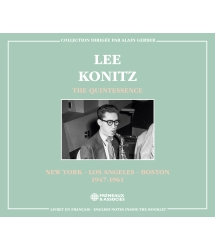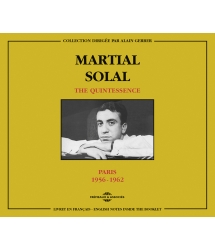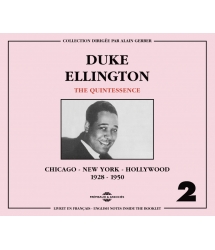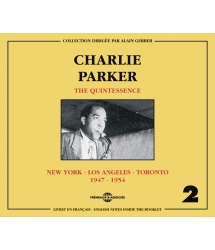- Our Catalog
- Philosophy
- Philosophers of the 20th century and today
- History of Philosophy (PUF)
- Counter-History and Brief Encyclopedia by Michel Onfray
- The philosophical work explained by Luc Ferry
- Ancient thought
- Thinkers of yesterday as seen by the philosophers of today
- Historical philosophical texts interpreted by great actors
- History
- Books (in French)
- Social science
- Historical words
- Audiobooks & Literature
- Our Catalog
- Jazz
- Blues
- Rock - Country - Cajun
- French song
- World music
- Africa
- France
- Québec / Canada
- Hawaï
- West Indies
- Caribbean
- Cuba & Afro-cubain
- Mexico
- South America
- Tango
- Brazil
- Tzigane / Gypsy
- Fado / Portugal
- Flamenco / Spain
- Yiddish / Israel
- China
- Tibet / Nepal
- Asia
- Indian Ocean / Madagascar
- Japan
- Indonesia
- Oceania
- India
- Bangladesh
- USSR / Communist songs
- World music / Miscellaneous
- Classical music
- Composers - Movie Soundtracks
- Sounds of nature
- Our Catalog
- Youth
- Philosophy
- News
- How to order ?
- Receive the catalog
- Manifesto
- Dictionnary











- Our Catalog
- Philosophy
- Philosophers of the 20th century and today
- History of Philosophy (PUF)
- Counter-History and Brief Encyclopedia by Michel Onfray
- The philosophical work explained by Luc Ferry
- Ancient thought
- Thinkers of yesterday as seen by the philosophers of today
- Historical philosophical texts interpreted by great actors
- History
- Books (in French)
- Social science
- Historical words
- Audiobooks & Literature
- Our Catalog
- Jazz
- Blues
- Rock - Country - Cajun
- French song
- World music
- Africa
- France
- Québec / Canada
- Hawaï
- West Indies
- Caribbean
- Cuba & Afro-cubain
- Mexico
- South America
- Tango
- Brazil
- Tzigane / Gypsy
- Fado / Portugal
- Flamenco / Spain
- Yiddish / Israel
- China
- Tibet / Nepal
- Asia
- Indian Ocean / Madagascar
- Japan
- Indonesia
- Oceania
- India
- Bangladesh
- USSR / Communist songs
- World music / Miscellaneous
- Classical music
- Composers - Movie Soundtracks
- Sounds of nature
- Our Catalog
- Youth
- Philosophy
- News
- How to order ?
- Receive the catalog
- Manifesto
- Dictionnary
LIVE IN PARIS - 21 MARS / 11 OCTOBRE 1960
MILES DAVIS
Ref.: FA5451
EAN : 3561302545127
Label : Frémeaux & Associés
Total duration of the pack : 3 hours 23 minutes
Nbre. CD : 4
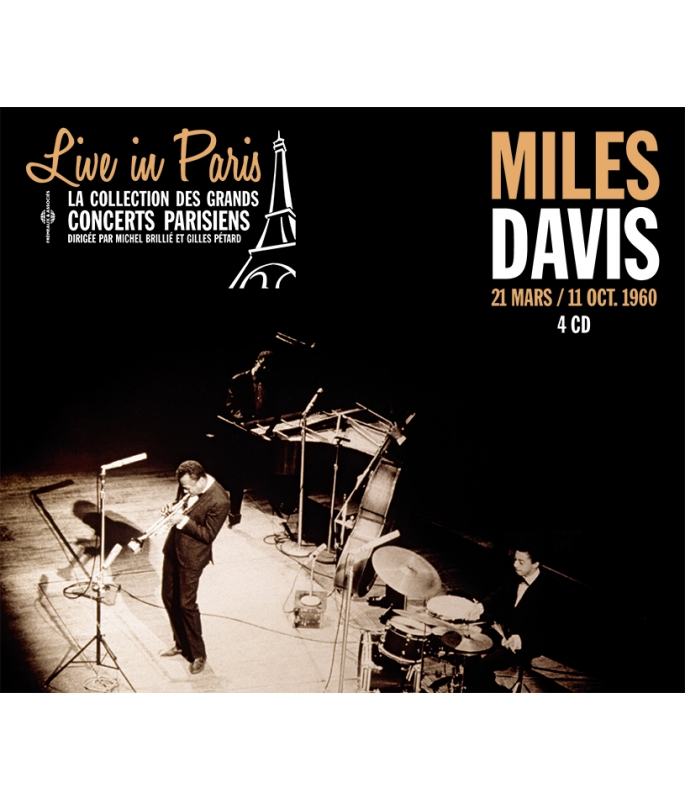
LIVE IN PARIS - 21 MARS / 11 OCTOBRE 1960
LIVE IN PARIS - 21 MARS / 11 OCTOBRE 1960
Revered by the artistic elite — from Saint-Germain’s jazz-cellars to the films of the Nouvelle Vague —, Miles Davis was an event every time he appeared in Paris and is still an authentic icon in France. A few months after the release of “Kind of Blue” in March 1960, Miles undertook a European tour with Wynton Kelly, Paul Chambers, Jimmy Cobb and John Coltrane. Europeans discovered Miles’ avantgarde saxophonist for the first time, a shooting-star in jazz history who defined a whole section of the music’s modern structure. The album marked a turning-point in jazz, in some way announcing the free revolution still to come, and it was also historic because you can hear both catcalls and applause in the divided audience as they followed Trane’s explorations of the music. The second part of this set was recorded the following winter; Sonny Stitt has stepped in for Coltrane, and the group’s work shows a liberated trumpeter: Miles Davis at the peak of his art. Patrick FRÉMEAUX
The Live in Paris collection by Michel Brillié allows listeners to hear previously-unreleased recordings (made at concerts and private- or radio-sessions) by the great 20th stars in jazz, rock & roll and song. These “live” takes, and the artists’ rapport with their audiences, gives these performances an additional soul and sensibility in counterpoint to the rigorous demands of studio recordings. Particular care was taken when restoring the sound of these tapes in order to meet CD standards while preserving the original colours of the period. Patrick FRÉMEAUX & Gilles PÉTARD
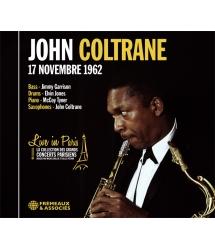
17 NOVEMBRE 1962
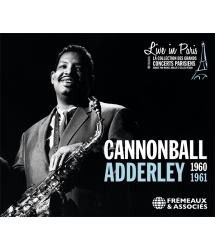
Live in Paris – 1960-1961

FEATURING LALO SCHIFRIN
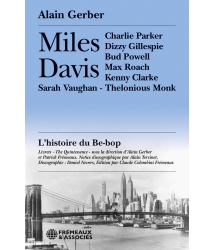
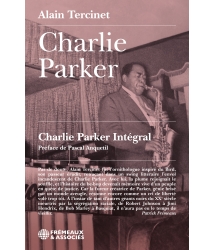
Un livre d'Alain Tercinet - Préface de Pascal...





-
PisteTitleMain artistAutorDurationRegistered in
-
1All Of YouMiles Davis/John Coltrane/Wynton Kelly/Paul Chambers/Jimmy CobbCole Porter00:17:081960
-
2So WhatMiles Davis/John Coltrane/Wynton Kelly/Paul Chambers/Jimmy Cobb00:13:081960
-
3On Green Dolphin' StreetMiles Davis/John Coltrane/Wynton Kelly/Paul Chambers/Jimmy CobbNed Washington00:14:421960
-
PisteTitleMain artistAutorDurationRegistered in
-
1WalkingMiles Davis/John Coltrane/Wynton Kelly/Paul Chambers/Jimmy Cobb00:15:551960
-
2Bye Bye Black BirdMiles Davis/John Coltrane/Wynton Kelly/Paul Chambers/Jimmy CobbM. Dixon00:14:001960
-
3Round About MidnightMiles Davis/John Coltrane/Wynton Kelly/Paul Chambers/Jimmy CobbB. Hanighen00:05:391960
-
4OleoMiles Davis/John Coltrane/Wynton Kelly/Paul Chambers/Jimmy Cobb00:04:251960
-
5The ThemeMiles Davis/John Coltrane/Wynton Kelly/Paul Chambers/Jimmy Cobb00:00:501960
-
PisteTitleMain artistAutorDurationRegistered in
-
1Walkin'Miles Davis/Sonny Stitt/Wynton Kelly/Paul Chambers/Jimmy Cobb00:11:451960
-
2Autumn LeavesMiles Davis/Sonny Stitt/Wynton Kelly/Paul Chambers/Jimmy CobbJacques Prévert00:13:011960
-
3FourMiles Davis/Sonny Stitt/Wynton Kelly/Paul Chambers/Jimmy Cobb00:08:461960
-
4UndidentifiedMiles Davis/Sonny Stitt/Wynton Kelly/Paul Chambers/Jimmy Cobb00:05:051960
-
5Round MidnightMiles Davis/Sonny Stitt/Wynton Kelly/Paul Chambers/Jimmy CobbB. Hanighen00:05:411960
-
6No BluesMiles Davis/Sonny Stitt/Wynton Kelly/Paul Chambers/Jimmy Cobb00:14:321960
-
7The ThemeMiles Davis/Sonny Stitt/Wynton Kelly/Paul Chambers/Jimmy Cobb00:00:471960
-
PisteTitleMain artistAutorDurationRegistered in
-
1Walkin'Miles Davis/Sonny Stitt/Wynton Kelly/Paul Chambers/Jimmy Cobb00:09:371960
-
2If I Were A BellMiles Davis/Sonny Stitt/Wynton Kelly/Paul Chambers/Jimmy Cobb00:11:591960
-
3Fran DanceMiles Davis/Sonny Stitt/Wynton Kelly/Paul Chambers/Jimmy Cobb00:07:241960
-
4Two Bass HitMiles Davis/Sonny Stitt/Wynton Kelly/Paul Chambers/Jimmy CobbJohn Lewis00:05:501960
-
5All Of YouMiles Davis/Sonny Stitt/Wynton Kelly/Paul Chambers/Jimmy CobbCole Porter00:13:041960
-
6So WhatMiles Davis/Sonny Stitt/Wynton Kelly/Paul Chambers/Jimmy Cobb00:09:271960
-
7The ThemeMiles Davis/Sonny Stitt/Wynton Kelly/Paul Chambers/Jimmy Cobb00:01:011960
Miles Davis Live in Paris FA5451
Live in Paris
La collection des grands concerts parisiens
Dirigée par Michel Brillié et Gilles Pétard
MILES DAVIS
21 MARS / 11 OCT. 1960
Miles Davis & John Coltrane 21 Mars 1960
Miles Davis & Sonny Stitt 11 Octobre 1960
LIVE IN PARIS
Miles à Paris, Paris à Miles… La ville où le musicien se retrouve en ce lundi 21 mars 1960 occupe une place particulière dans sa vie et dans son coeur. Trois décennies après, c’est aussi à Paris, à la Grande Halle de la Villette, qu’il donnera l’un de ses derniers concerts, le mercredi 10 juillet 1991, quelques semaines avant sa mort.
Miles Davis a découvert la capitale française en mai 1949, lors de son premier voyage à l’étranger, à l’occasion du Festival International de Jazz à la salle Pleyel, où il se produit à la tête d’un quintet en compagnie du pianiste Tadd Dameron. Dans la coulisse, Michelle Vian, l’épouse de Boris et sa copine Juliette Gréco regardent, fascinées, le jeune et beau trompettiste de 23 ans. Miles tombe sous le charme de la chanteuse à la longue chevelure brune, et rencontre ainsi l’élite intellectuelle et artistique parisienne de l’époque. « C’était mon premier voyage à l’étranger, et il a changé à jamais ma vision des choses, écrit-il dans son autobiographie. J’adorais être à Paris, j’adorais la façon dont on me traitait. C’est là que j’ai rencontré Jean-Paul Sartre, Pablo Picasso et Juliette Gréco. Je ne m’étais jamais senti aussi bien de ma vie. » Paris est alors ville de tolérance et d’ouverture : Miles Davis a la sensation d’être « traité comme un être humain ».
Sept ans plus tard, en 1956, Miles revient à Paris pour une tournée européenne, avec en sidemen le trio d’un jeune pianiste de 22 ans – de Paris - René Urtreger. L’histoire raconte qu’encore une fois le jazzman se lie avec une jeune parisienne, en l’occurrence la sœur du pianiste, Jeannette. C’est elle qui aurait convaincu Miles d’assister un an plus tard à la projection d’un film en gestation réalisé par un jeune loup du cinéma d’auteur, Louis Malle : « Ascenseur pour l’échafaud ». En tout cas c’est bien en décembre 1957 que Miles Davis, à Paris pour un engagement de plusieurs semaines au Club Saint Germain avec Urtreger et le batteur expat’ Kenny Clarke, improvise en 3 heures la musique du film sous le regard de Jeanne Moreau.
Pendant 40 ans, la relation Paris-Davis restera constante : en Octobre 2009, la Cité de la Musique l’honorera avec « We Want Miles », une exposition entièrement dédiée au grand musicien.« Miles me parlait souvent de Paris », se souvient le réalisateur australien Rolf de Heer « Il y appréciait cette forme de respect qu’il n’avait pas dans son pays natal. » Comme le remarque aussi le pianiste René Urtreger, « Miles était fier et touché qu’en France, le jazz était considéré comme un genre musical essentiel. »
Retour sur ce 21 mars 1960, quelques jours après la décision du président américain Eisenhower d’envoyer pour la 1ère fois 3500 GIs au Vietnam - et trois mois après l’enregistrement du mythique album «Kind of Blue» de Miles Davis. Comme à l’accoutumée, le promoteur Norman Granz a embarqué sa tournée « Jazz At The Philharmonic » à travers l’Europe. Le programme est prestigieux : le Oscar Peterson Trio, le Stan Getz Quartet et le Miles Davis Quintet. Le périple débute à Paris ce lundi 21 mars, puis va se poursuivre dans toutes les grandes villes du continent, Stockholm, Copenhague, Berlin, Hambourg, Vienne, , Zurich, Amsterdam… jusqu’au 10 avril. Au sein du quintet du génial jazzman, l’atmosphère est plutôt tendue : depuis février, le saxophoniste ténor John Coltrane a déclaré à Miles qu’il souhaite quitter le groupe. Mais le trompettiste a convaincu Coltrane d’attendre la fin de la tournée européenne. Ambiance, ambiance… De plus, des divergences artistiques fondamentales les séparent : dans l’exploration du nouveau terrain du jazz modal, Miles veut que ses sidemen « fassent plus simple », pour poursuivre un style minimaliste. Coltrane, à l’opposé, triture l’harmonie de ses «sheets of sound», ses nappes de sons éclaboussantes. Ce lundi soir, le ténor est conspué par une bonne partie du public parisien, dérouté par ses explorations audacieuses. La presse du lendemain se lâche pour décrire l’éblouissant ténor :
« L’écho d’une brousse, une Afrique aveugle » selon France-Observateur… « Le 21 mars, c’était comme la première du « Sacre du printemps » du jazz moderne » (Charles Estienne)
« Coltrane joue d’une façon tellement insensée, éclatante que nous restons paralysés dans nos fauteuils » (Pierre Fallan, Arts)
Dans Jazz Magazine de mai 1960, quelques spectateurs avertis livrent un avis mitigé : « Des gargarismes, des étalages de virtuosité dont la longueur était un peu essoufflante et crispante » commente le violoniste Stéphane Grappelli. « Un véritable choc…Coltrane jette à l’assistance des poignées d’harmonie, déverse des pluie de notes sur la rythmique… » Le batteur Daniel Humair est clairement fan. Pour Daniel Filipacchi, l’un des producteurs du concert, Coltrane crée dans ses prestations en live «une tension et un climat obsessionnel étonnants, mais à mon avis lassants » Ce concert mythique, où Coltrane vole clairement la vedette à Miles, voit l’éclatement du style libre et lyrique du saxophoniste, qui dira après le concert : « Si les gens ont hué, c’est que je ne suis pas allé assez loin. »
Frank Ténot et Daniel Filipacchi font revenir Miles Davis à l’Olympia à l’automne 1960, le 11 octobre, en compagnie du saxophoniste Sonny Stitt. Le ténor très parkerien a remplacé Coltrane, qui a quitté le quintet en avril à Baltimore, après son retour aux USA. Cette fois-ci, Miles reprend les choses en main et se situe sur le devant de la scène. Pas de bronca pour le public ce mardi soir : si le trompettiste avait eu une attitude jugée méprisante lors de sa prestation avec Coltrane, en tournant le dos à la salle voire en se réfugiant en coulisses, Miles Davis est en grande forme pour cette soirée avec Stitt: non seulement il condescend à rester sur scène, mais encore il sera surpris à plusieurs reprises avec un gentil sourire aux lèvres… Nice Smile, Nice Miles.
Dédié à Claude Boquet, Bill Dubois, Jean Claude, Philippe Moch et toute la bande.
Michel BRILLIÉ
© FRÉMEAUX & ASSOCIÉS 2014
Miles Davis & John Coltrane March 21st,1960
Miles Davis & Sonny Stitt October 11th 1960
LIVE IN PARIS
Miles in Paris, Paris in Miles.. For more than 40 years, the city of lights holds a special place with the jazz trumpeter. On this Monday March 21, 1960 as much as on Wednesday July 10, 1991, when Davis will play one of his final concerts in The Grande Halle de la Villette, just a few weeks before his death.
Miles Davis has discovered le French capital as early as May 1949. On his first trip abroad, he performs at the Festival International du Jazz at the Salle Pleyel, with a quintet that includes pianist Tadd Dameron. In the wings stand 2 pretty parisiennes, Michelle Vian, wife of famous Saint Germain des Prés figure Boris Vian, and a friend, singer Juliette Gréco. Both are fascinated by the young and good looking 23 year-old trumpeter. Miles falls for the charming brunette and is therefore introduced to the intellectual and artistic elite of the period. “This was my first trip out of the country,” recalled Davis in his autobiography. “It changed the way I looked at things forever... This is where I met Jean Paul Sartre, Pablo Picasso and Juliette Gréco… I loved being in Paris and loved the way I was treated. Paris was where I understood that all white people were not the same; that some weren’t prejudiced.”
Even years later, in 1956, Miles is back in Paris for another European tour, backed by a trio of young French sidemen, such as René Urtreger. The story goes that once again he has an affair with a Paris lady, Jeannette, who happens to be Urtreger’s sister. A year later, Jeanne is credited with taking Miles Davis to private screening of the almost completed film of an innovative newcomer in cinema, Louis Malle. It’s “Ascenseur pour l’Echafaud” (Lift to the Scaffold). What is certain is that Davis, back in Paris in December 1957 for a lengthy gig at the Club Saint Germain with Urtregrer and expatriate drummer Kenny Clarke, records the film’s soundtrack in one night with actress Jeanne Moreau as an onlooker.
And for four decades, the bond Paris-Davis has remained constant. In October 2009, the Cité de la Musique Museum in Paris honored the musician in “We Want Miles”, an exhibit entirely dedicated to Davis. “Miles often talked about Paris,” says the Australian film director Rolf de Heer, who worked with Davis in Paris in 1990. “He liked that because it was a form of respect he didn’t get in his own country.” Sideman René Urtreger comments: “Miles was proud and touched by the fact that in France, jazz was considered to be very important music.”
Back to March 21, 1960. It is a few days after General Eisenhower’s decision to send for the first time 3.500 US soldiers to Vietnam, and 3 months after the recordings sessions of the mythical album “Kind of Blue”. As usual, Norman Granz has embarked his now illustrious “Jazz At The Philharmonic” tour throughout Europe. The line-up is impressive: the Oscar Peterson Trio, the Stan Getz Quartet and the Miles Davis Quintet. The tour starts in Paris on this Monday night and is afterwards booked up to April 10 in various European cities, Stockholm, Copenhagen, Berlin, Hamburg, Vienna, Zurich, and Amsterdam. Inside the quintet, the mood is tense. Since February,
Coltrane has expressed his desire to leave the group. But Miles has convinced Coltrane to wait until the end of this European tour. In addition, the two men are separated by fundamental artistic differences: in this new ground of modal jazz Davis wants his partners to be simpler, almost minimalist. In contrast, Coltrane develops his “Sheets of sound” brilliant improvisations.
On this Monday night, the tenor is booed by half of the Parisian audience, probably put off by his daring innovations. The next day, the French newspapers give the concert a thundering write-up:
“It is the echo of the bush, of a blind Africa… This first day of spring, March 21, was the opening night of the “Rite of Spring” of modern jazz” raves Charles Estienne in France-Observateur.
“Coltrane plays in such a demented, brilliant way that we stay paralyzed in our seats” writes Pierre Fallan of Arts.
In the May 1960 issue of Jazz Magazine, some of the personalities in the public express mixed feelings. Violin jazzman Stéphane Grappelli declares “all these gargles, all this display of virtuosity are in the long run tiring and unnerving.” On the contrary, drummer Daniel Humair is a definite fan: “What a jolt! Coltrane throws fistfuls of harmonies to the audience, he pours a heavy rain of notes on the rhythm section…” For Daniel Filipacchi, one of the concert’s promoters, Coltrane generates during his live appearances “an astonishing and obsessional climate of tension – and tiresome, in my opinion.”
This mythical concert, during which Coltrane clearly steals the show from Davis, acknowledges the emergence of the lyrical freeform style of the saxophonist. Following his performance, John Coltrane comments the Paris crowd’s reaction: “If they booed, it’s because I didn’t go far enough.”
In the fall of 1960, Frank Ténot and Daniel Filipacchi bring Miles Davis back to the Olympia Hall in Paris, this time with Sonny Stitt. The Parkerian tenor has replaced Coltrane who left the group in Baltimore when the quintet returned to the States in April. This time, Miles takes care of business and stands up front. No more booing from the audience on this Tuesday night: the jazz trumpeter doesn’t turn his back to the audience any more, nor does he retreat in the wings. Davis is in great shape for this gig with Stitt. He remains on stage throughout the evening, and on several occasions, puts a gentle smile on his lips… Nice Smile, Nice Miles.
Michel BRILLIÉ
Dedicated to Claude Boquet, Bill Dubois, Jean Claude, Philippe Moch and the gang
© FRÉMEAUX & ASSOCIÉS 2014
Miles Davis & John Coltrane 21 mars 1960
CD 1
1. All of You (Cole Porter/Cole Porter) 17’08
2. So What (Miles Davis) 13’28
3. On Green Dolphin Street (Ned Washington / Bronislau Kaper) 14’42
Total time 45’18
CD 2
1. Walking (Richard Carpenter) 15’55
2. Bye Bye Blackbird (Mort Dixon / Ray Henderson) 14’00
3. Round About Midnight (Bernie Hanighen / Thelonious Monk / Cootie Williams) 5’39
4. Oleo (Sonny Rollins) 4’25
5. The Theme (Miles Davis) 0’50
Total time 40’49
Miles Davis & Sonny Stitt 11 Oct 1960
CD 3
1. Walkin’ (Richard Carpenter) 11’45
2. Autumn Leaves (Jacques Prévert / Joseph Kosma) 13’12
3. Four (Miles Davis) 8’46
4. Unidentified (Sonny Stitt) 5’05
5. Round Midnight (Bernie Hanighen / Thelonious Monk / Cootie Williams) 5’41
6. No Blues (Miles Davis) 14’32
7. The Theme (Miles Davis) 0’47
Total time 59’48
CD 4
1. Walkin’ (Richard Carpenter) 9’37
2. If I Were a Bell (Frank Loesser) 11’59
3. Fran Dance (Miles Davis) 7’24
4. Two Bass Hit (John Lewis / Dizzy Gillespie) 5’50
5. All of You (Cole Porter / Cole Porter) 13’04
6. So What (Miles Davis) 9’27
7. The Theme (Miles Davis) 1’01
Total time 58’22
Recorded by: Europe N°1 Technical Staff
Recording date
March 21, 1960
Recording place
Olympia Theater, Paris France
Produced by: Frank Ténot & Daniel Filipacchi
Personnel
Miles Davis: Trumpet
John Coltrane: Sax
Wynton Kelly: Piano
Paul Chambers: Bass
Jimmy Cobb: Drums
Vénéré par le tout-Paris artistique, des caves de jazz de Saint-Germain aux films de la Nouvelle Vague, Miles Davis, dont chaque passage à Paris est un événement, est une véritable icône en France. Quelques mois après la sortie de « Kind of Blue », il entame, en mars 1960, une tournée européenne avec Wynton Kelly, Paul Chambers, Jimmy Cobb et John Coltrane. Les Européens découvrent alors pour la première fois le saxophoniste avant-gardiste, étoile filante de l’histoire du jazz, dont il allait définir tout un pan de la charpente moderne. Un enregistrement qui marque une époque charnière pour le jazz et annonce d’une certaine manière la révolution free à venir, mais également historique, car on peut y entendre un public divisé, sifflant ou ovationnant les explorations musicales du saxophoniste new-yorkais. La deuxième partie de ce coffret, enregistrée l’hiver suivant et dans laquelle John Coltrane est remplacé par Sonny Stitt, présente un Miles Davis libéré, au sommet de son art.
Patrick FRÉMEAUX
Revered by the artistic elite — from Saint-Germain’s jazz-cellars to the films of the Nouvelle Vague —, Miles Davis was an event every time he appeared in Paris and is still an authentic icon in France. A few months after the release of “Kind of Blue” in March 1960, Miles undertook a European tour with Wynton Kelly, Paul Chambers, Jimmy Cobb and John Coltrane. Europeans discovered Miles’ avant-garde saxophonist for the first time, a shooting-star in jazz history who defined a whole section of the music’s modern structure. The album marked a turning-point in jazz, in some way announcing the free revolution still to come, and it was also historic because you can hear both catcalls and applause in the divided audience as they followed Trane’s explorations of the music. The second part of this set was recorded the following winter; Sonny Stitt has stepped in for Coltrane, and the group’s work shows a liberated trumpeter: Miles Davis at the peak of his art.
Patrick FRÉMEAUX
La collection Live in Paris, dirigée par Michel Brillié, permet de retrouver des enregistrements inédits (concerts, sessions privées ou radiophoniques), des grandes vedettes du jazz, du rock & roll et de la chanson du XXe siècle. Ces prises de son live, et la relation avec le public, apportent un supplément d’âme et une sensibilité en contrepoint de la rigueur appliquée lors des enregistrements studios. Une importance singulière a été apportée à la restauration sonore des bandes, pour convenir aux standards CD tout en conservant la couleur d’époque.
Patrick FRÉMEAUX & Gilles PÉTARD
The Live in Paris collection by Michel Brillié allows listeners to hear previously-unreleased recordings (made at concerts and private- or radio-sessions) by the great 20th stars in jazz, rock & roll and song. These “live” takes, and the artists’ rapport with their audiences, gives these performances an additional soul and sensibility in counterpoint to the rigorous demands of studio recordings. Particular care was taken when restoring the sound of these tapes in order to meet CD standards while preserving the original colours of the period.
Patrick FRÉMEAUX & Gilles PÉTARD
CD Miles Davis - Live in Paris 21 mars-11 octobre 1960, Miles Davis © Frémeaux & Associés 2014.
NEW YORK CITY JAZZ RECORD REVIEW
By ANDERS GRIFFEN
“The Miles Davis European tours of 1960 have been widely discussed and debated by musicians and fans alike. John Coltrane is the primary subject for most of it as he bursts forth with revolutionary music. Writing for the France-Observateur, Charles Estienne likened the performances to the reception of Stravinsky’s “Le Sacre du Printemps”. Recorded for radio or bootlegged, recordings from these tours have been issued over the years by several imprints, including Miles Davis in Stockholm 1960 Complete (Dragon) and All of You: The Last Tour (Acrobat). The music on this new release was professionally recorded and has been previously issued on Miles Davis En Concert Avec Europe1 (Trema) and, in part, on Miles Davis featuring John Coltrane: Olympia-Mar 20, 1960 (Delta), on which the date is incorrect; the first night of the tour took place on Monday, Mar. 21st, 1960.
Miles was outspoken about continuous development and change and is a great example of an artist realizing this mission. In this moment, captured on these recordings, he met his match. One year after Kind of Blue was recorded and ten months after the recording of Coltrane’s Giant Steps, Coltrane had tendered his resignation, as reported by the Philadelphia Tribune on Mar. 15th and DownBeat on the 17th and was already moving on. Somehow Miles compelled the reluctant saxophonist to make the tour. “He decided to go with us,” Miles states in his autobiography, “but he grumped and complained and sat by himself all the time we were over there.” It was his first trip to Europe and Coltrane’s performance is legendary on these dates. He was undergoing a rapid process of discovery, characterized by an obsession with harmony. While the jazz world was still beginning to deal with Giant Steps, it was already behind him. Trane was now free to explore harmonic relationships on any tune in the band’s set. This new vocabulary, including multiphonics, rapid-fire arpeggios and diminished sequences, is heard throughout. He embarks on his solos with simple enough themes and develops them until torrential “sheets of sound” fly with conviction. The open form of “So What” is the best vehicle for his flights, but he has his way with the blues on “Walkin’” and, around the 2:10 mark on “Oleo”, one can hear the opening theme of “A Love Supreme”. Many concertgoers did not like what they heard and boos are mixed with cheers during his solos, particularly on “Walkin’” and “Bye Bye Blackbird”. It was shocking then and listeners today can still hear it given the stark contrast between his solos and the rhythm section of Wynton Kelly (piano), Paul Chambers (bass) and Jimmy Cobb (drums).
The latter trio sounds fantastic throughout and the audience cheers loudly for them, but they may be slightly more in their element when the band returned to Europe in October and Sonny Stitt took the saxophone chair. They reach back and play in a bop mode that pre-dates Kind of Blue and add tunes like “Autumn Leaves”, “If I Were A Bell” and “Two Bass Hit”. An “unidentified” tune credited to Stitt is a 12-bar blues in the odd key of Db; perhaps that’s why the saxophonist is the only soloist. This is a great performance in well-known territory and the crowd goes wild.
Miles Davis Live in Paris makes these legendary concerts available again and is enjoyable to a crowd of fans. It’s exciting to witness how challenging the Coltrane performances were for the audience in attendance. Folks that prefer pre-Impulse Coltrane can best appreciate his break from the familiar vocabulary while hearing him backed by this straightahead rhythm section. Meanwhile, for the listeners who insist on a soloist with more of a straightahead rapport with the rhythm section, the sets with Stitt are burning! Miles sounds every bit as genuine in these very different settings, pushing the envelope behind Trane and swinging hard alongside Stitt.”
By Anders GRIFFEN – THE NEW YORK CITY JAZZ RECORD
